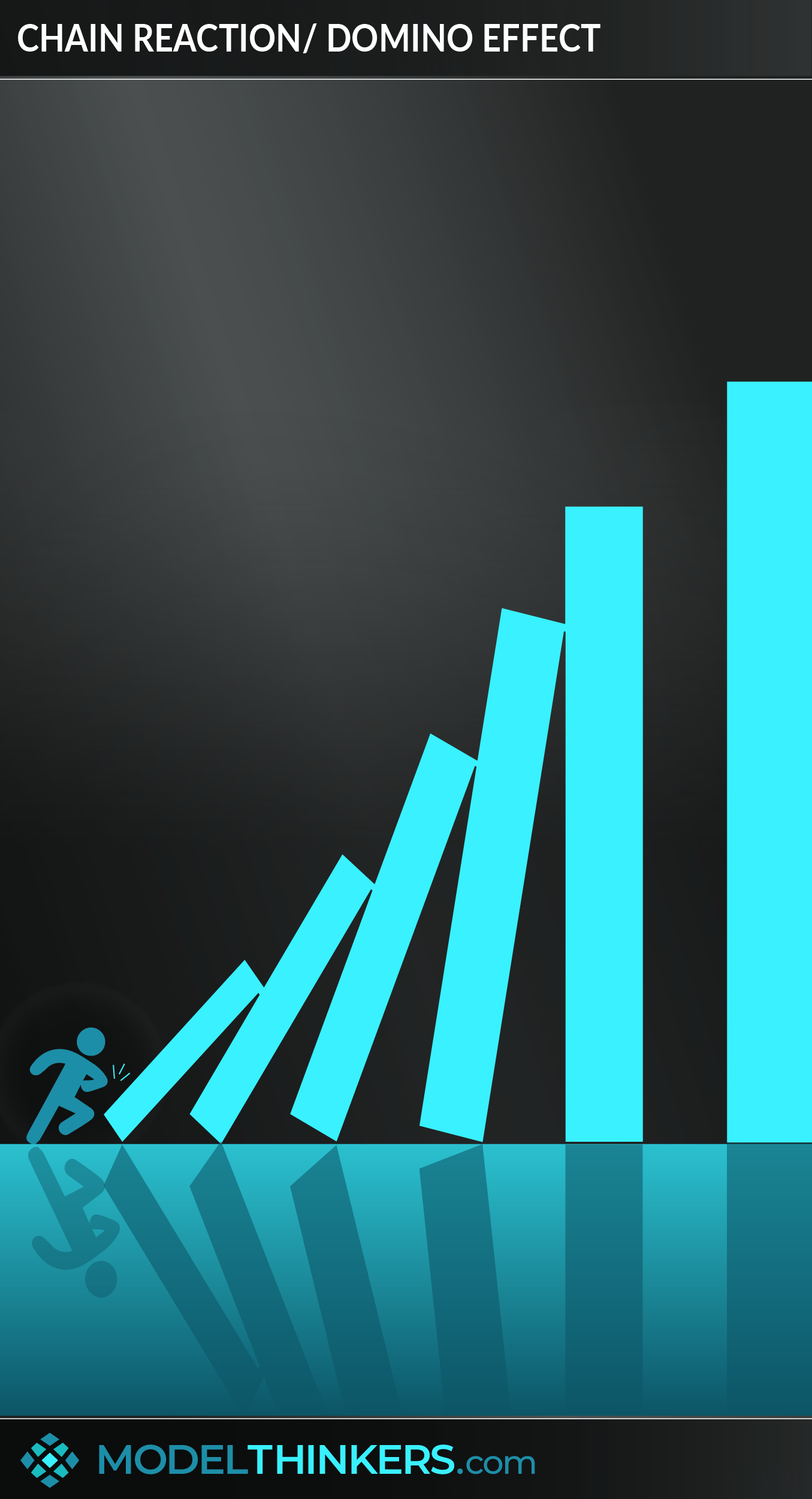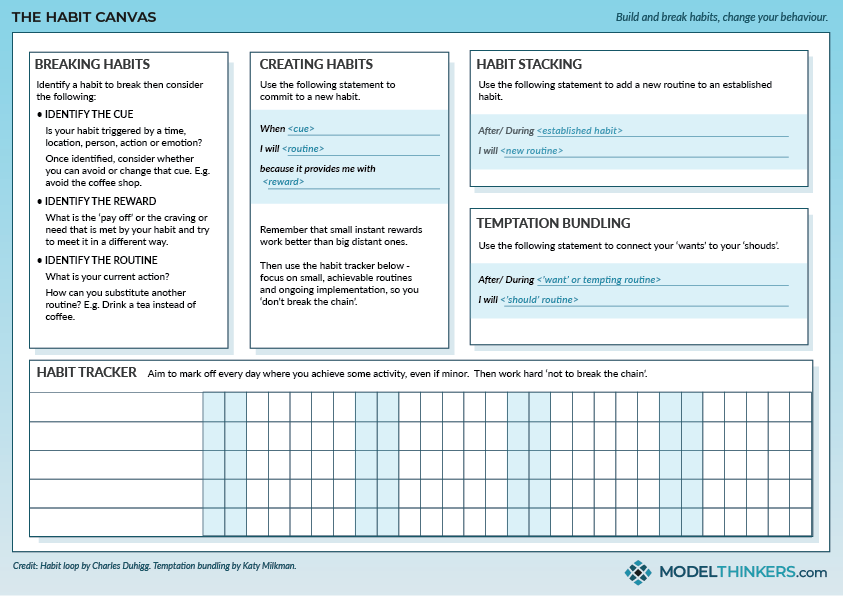

 0 saved
0 saved
 37.5K views
37.5K views








This model highlights the power of creating momentum or flow, from a small initial action.
A Chain Reaction occurs when a single initial event triggers a chain of other events, similar to knocking over a single domino resulting in an entire row of dominoes falling.
FROM CHEMISTRY TO HABITS.
Inspired from chemistry, where a reactive product or byproduct causes cycles of repeated reactions, this model most well-known form is a nuclear chain reaction.
That said, it's a versatile model that can be applied to multiple domains. See the in practice examples below to see how Admiral McRaven creates a 'good day' by making his bed; or how Seinfeld used the 'don't break the chain' approach to writing comedy. Actually, be sure to check out the in practice section for the very awesome domino video — you'll see what I mean.
Beyond that, in business the model might involve marketing to a particular segment, knowing that winning them will likely lead to other segments following. It's a clever way to reduce Activation Energy and build momentum.
IN YOUR LATTICEWORK.
View the toolkit below and download the Habit Canvas to see how this model combines with the Habit Loop and Temptation Bundling to create lasting behaviour change.
It has many parallels to Compounding and works well in conjunction with Critical Mass.
The Domino Effect is particularly applied through the tracker aspect with the focus on 'not breaking the chain'. See the Takeaways for more on this.




- Don’t break the chain.
This method of maintaining momentum involves identifying the unbroken series of days you’ve managed to maintain a behaviour. It’s used in workplaces which proclaim ‘x days since our last accident’ and can be used to impact on behaviour change by establishing and promoting a sense of momentum. Again, view the habit tracker component in the habit canvas below as an example.
- Break up a complex problem.
Rather than seeing something as a large challenge, break it down into key components. These elements, and their interrelationships, are crucial to creating a chain reaction.
- Look for connections to identify potential chains.
Whether you are applying this model to behaviour change, business growth, marketing or anything, the first step involves identifying potential clusters of connections. Which elements are inter-related and will likely trigger a flow-on effect?
- Start with critical and/or low effort.
Once you have identified clusters of connections, identify if there is a natural starting point that will likely have the most impact and potential to cascade. This is similar to finding the domino at the beginning of a row. Alternatively, it might be more practical to find a starting point that is easiest or has the least activation energy for you.
- Identify what will create momentum.
This mental model is about identifying where you find momentum after an initial effort. What is likely going to get things moving and keep things moving by impacting other elements. Ask yourself, ‘is this the best move to create momentum?’
In real life, causal relationships are generally not so simple as a series of dominoes. Often the causal relationship is hard to identify and it's difficult to know what will and will not start a chain reaction. Even where a relationship does exist, other elements might conspire to prevent such a chain reaction.
An amazing domino video.
Watch this fascinating video where a tiny domino eventually knocks over an extremely large one, in a visual demonstration of this mental model.
Make your bed in the morning.
This 2014 commencement speech by Admiral William McRaven argued that people should make their bed in the morning to initiate a chain reaction of positive behaviour.
McRaven explained: “If you make your bed every morning you will have accomplished the first task of the day. It will give you a small sense of pride, and it will encourage you to do another task and another and another. By the end of the day, that one task completed will have turned into many tasks completed.”
Jerry Seinfeld, not breaking the chain.
Seinfeld famously put a red ‘X’ on his calendar for every day he wrote a joke. This motivated him not to ‘break the chain’ and continue creating jokes.
Chain reaction or domino effect is a powerful productivity mental model and one that can be applied to a range of areas to create change with smaller upfront energy.
Use the following examples of connected and complementary models to weave chain reaction/ domino effect into your broader latticework of mental models. Alternatively, discover your own connections by exploring the category list above.
Connected models:
- Compounding / snowball effect:
- Catalyst: another way of lowering activation energy.
- Leverage: the approach of investing less to get more has similarities.
- Activation energy: Understanding where it lies and how to gain momentum beyond an initial expenditure.
- Systems vs goals: particularly in relation to ‘don’t break the chain’.
- Critical mass/ tipping point: in considering how to gain momentum.
- Compounding/ snowball effect: a similar mental model that emphasises exponential growth.
- Butterfly effect: can be seen as a potential implication of the domino effect or chain reaction.
Complementary models:
- Divide and rule: the process of breaking something down into parts.
- 4Ps of marketing: looking for a potential domino effect in relation to targeting influencers and segments.
- Habit formation: similar to the ‘make your bed’ example, creating a chain of positive behaviour.
German chemist Max Bodenstein first proposed the idea of a chain reaction in chemistry in 1913. He outlined the phenomena where two molecules reacting produce unstable molecules that go onto react with others, repeating the cycle over and over again.
The term gained prominence in regards to nuclear chain reactions. It was first proposed in this context by Hungarian-American physicist Leo Szilard in 1933.
More recently, James Clear wrote this compelling piece about how to apply the mental model to habit formation and behaviour change.
 My Notes
My Notes
Oops, That’s Members’ Only!
Fortunately, it only costs US$5/month to Join ModelThinkers and access everything so that you can rapidly discover, learn, and apply the world’s most powerful ideas.
ModelThinkers membership at a glance:






“Yeah, we hate pop ups too. But we wanted to let you know that, with ModelThinkers, we’re making it easier for you to adapt, innovate and create value. We hope you’ll join us and the growing community of ModelThinkers today.”






















































































